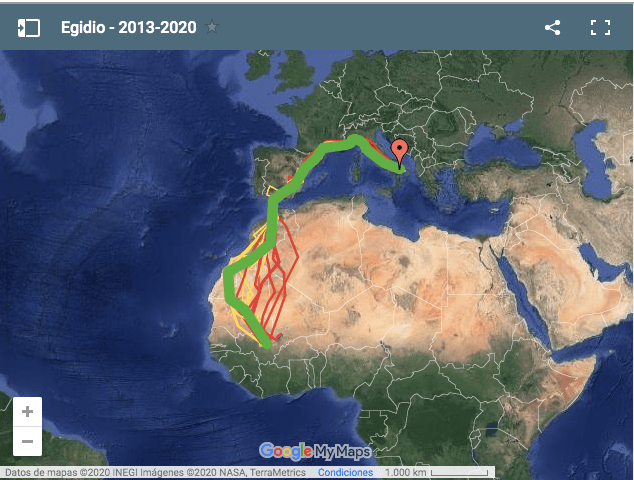A young Italian called Michele caused a frisson of excitement here in The Straits last month, turning up safe and well after being missing in Africa since mid-November! Not long after his reappearance he was on his adventures again, awaiting fine weather on the northern shores of Morocco before jetting across the Straits and spending the night just outside Sevilla.

The plucky individual is a young Short-toed Eagle, satellite-tagged in 2019 as part of a collaboration between MEDRAPTORS, the Vertebrate Zoology Group at the University of Alicante (Spain), and tag providers Tecnosmart. He is a second-generation project participant – his father Egidio was one of seven young eagles tagged between 2010 and 2013, who reached adulthood and bred successfully in 2019 while still transmitting data.
This father-son team continue to shed light on the surprising and convoluted migration of Short-toed Eagles from Italy. The two-kilo eagles wear their tiny GPS tags on their backs, and the fascinating story they tell has confirmed what many suspected. Instead of beginning the journey to their wintering grounds in sub-Saharan Africa by heading directly south to Tunisia, they start with a 1600-mile flight north and west, right up through the Italian Peninsula and across southern France, before crossing the Pyrenees and migrating down through the length of the Iberian Peninsula, more than doubling their journey distance to Africa´s shores.
The reason? it´s all about wings and Straits.


The long, elegant wings of this beautiful raptor mean it is perfectly adapted for soaring on air thermals, and it can do so for many hours, expending very little energy. But where there is no rising air – such as over expanses of water – the bird must beat those long wings to stay airborne, and becomes quickly exhausted.
Leaving the south-western point of Sicily, where Italy is at its closest to Africa, the bird would have to fly almost 100 miles to the next bit of land – an impossibility for such a long-winged raptor. So Italian Short-toed Eagles have learned to go directly against their strong instinct to head south, forcing themselves to fly north in order to eventually arrive in southern Spain. Here the mere 8.5-mile sea crossing at The Straits of Gibraltar presents much less of a challenge to a healthy, experienced bird choosing the right weather conditions.
While southerly migratory behaviour is innate, the study shows that this northerly trek must be learnt. First-year birds follow an adult who has already learnt the circuitous route to avoid the sea. Around 20% of first-year birds get it wrong and follow their hearts south, ending up wintering on Sicily because there is no more “south” to fly.
Michele was named after the late Michele Panuccio, the raptor researcher who studied the species for several years and promoted the tagging of Egidio’s first son, who was tagged a few weeks after he passed away. He left the nest site at the end of September, several days before his father, presumably following another adult bird. No doubt aided by years of experience, Egidio left late but made the journey in considerably less time. By the end of October, he had already arrived in Mauritania while Michele was still taking it easy in Extremadura!
When the lazy adolescent did finally make the crossing, the signal from his tracker was soon lost as he moved out of areas with the mobile coverage necessary to follow him. For the research team, there was nothing more to do except wait and hope that he had found his way to the wintering grounds safely. So when his tracker was spotted on the move again earlier this month, it must have been a tremendous relief!
His northward crossing of the Straits was unusual behaviour for such a young bird, as non-breeders would normally stay in Africa for another year, “finding themselves” until they come of age. Interestingly though, back in the day, dad Egidio was also a precocious exception to this rule – he too returned to the breeding grounds as a one-year-old.
This year, seven-year-old Egidio was no less keen to breed, and started his migration back to Italy as early as mid-February, arriving there by 12 March! In early March we spent some absolutely joyous days here in the Straits of Gibraltar, watching raptors arrive across the narrowest stretch of sea between Europe and Africa. We clapped them all as they arrived on our shores! We´d love to think that Egidio was one of them…
With thanks to Ugo Mellone of MEDRAPTORS and Universidad de Alicante for kindly giving permission for citation and reproduction of maps and data.
REFERENCES
Agostini N., Baghino L., Coleiro C., Corbi F. & Premuda G. 2002. Circuitous autumn migration in the Short-toed Eagle (Circaetus gallicus). Journal of Raptor Research 36: 111-114
Mellone U., Limiñana, R., Mallìa E. & Urios V. 2011. Extremely detoured migration in an inexperienced bird: interplay of transport costs and social interactions. Journal of Avian Biology 42: 468-472
Mellone U., Lucia G., Mallìa E., Urios V., 2016. Individual variation in orientation promotes a 3000-km latitudinal change in wintering grounds in a long-distance migratory raptor. Ibis DOI: 10.1111/ibi.12401
Panuccio, M., Agostini, N. & Premuda, G. 2012. Ecological barriers promote risk minimization and social learning in migrating short-toed snake eagles. Ethology Ecology and Evolution 24: 74-80.
